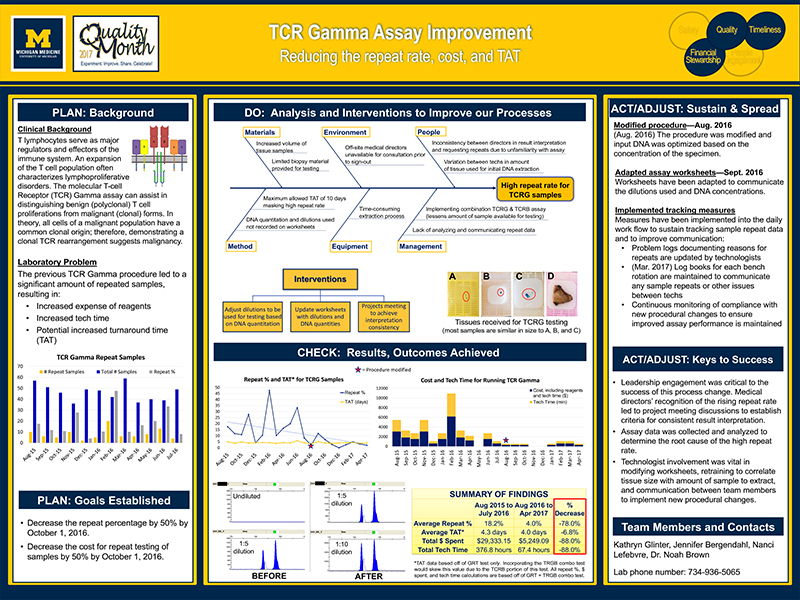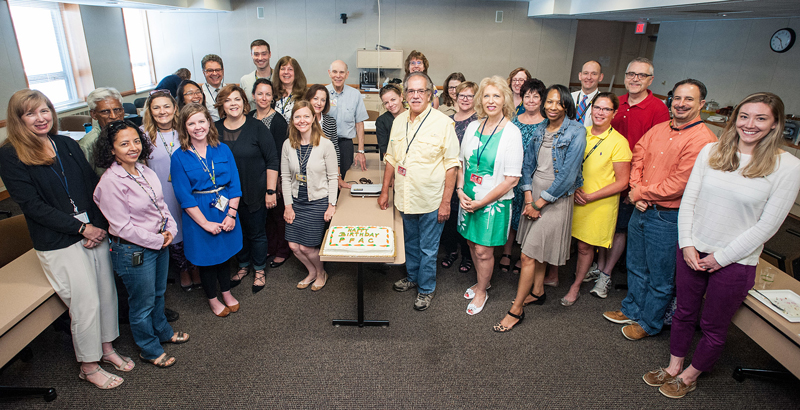Department of Pathology Updates - Vol 3.1
By Jeffrey Myers |
October 6
2017
Teammates,

It has been awhile (7 months almost to the day) since sending DOP Updates, an email shared with members of our Department of Pathology (DOP) and others regarding issues and events of common interest. Please send me a note if you have comments, questions or concerns that you would like to share. As in previous editions, I have also attached a
PDF to preserve formatting across platforms.
Navigating Michigan Medicine
My focus was my phone, having returned to a practice of distraction while navigating the busy lunch-time traffic that connects UH to the Cancer Center en route to a daily huddle.
She was stopped in the middle of traffic at the intersection of the Cancer Center and the café tables, her little girl close by her side as she demonstrated the expression common to those defeated by the complexities of our medical center.
I asked if I could help and she said that they were looking for Taubman Center after entering from the Cancer Center parking lot. I guided them around the lunchtime crowd and pointed down the long hallway explaining that her destination (reception B, 2nd floor) was at the end of it.
Her shoulders slumped as she leaned against the wall. “I can’t walk that far,” she said with exasperation.
She responded “Yes” when asked if she needed a wheelchair. Told her I’d be right back with one and set off concerned that the last time I made such a commitment I didn’t find a wheelchair until I got all the way to the Taubman Center entrance one floor down! As luck would have it there was an idle chair sitting in a designated space just inside the hospital.
Returned with her transportation and after settling her in the chair, asked her little girl if she would like to push. The joy that fueled the smile that launched her response was palpable and energizing! “I’m too little!” she said. So we settled on our roles, she as the carrier of my slides and me as the wheelchair locomotive.
Her smile never wavered as she began to talk, and clearly buoyed her mother’s spirits as she beamed with pride from her chair. Her backpack bounced on her back as she stepped lively, setting the pace for both of us.
And a day that began like any other seemed suddenly magical as she explained the value of being 7 compared to being 6 (“I can reach more stuff!”). She went on to educate me about the challenges of being faster afoot than her older brothers who resided in Texas (“They don’t like to lose.”). She explained that she had no school because of a computer malfunction and that her hope was to spend some time in Texas visiting her Grandmother who was all alone and in need of her granddaughter’s company.
We joined the line at reception B, the two of them confident that they could do what needed doing from there. But I wondered . . . how would they make the trip back to their car?
They both said goodbye with more kindness and gratitude than made sense to me, as I thanked them in return for brightening my day and wishing her well with her appointment.
Later I regretted not leaving my cell phone number should they find themselves in need of transportation back to the place from which their journey began.
Our hallways are filled with stories. Learning to hear them is the challenge. My cell phone is now back in my pocket; I would rather hear the next story.
Quality, Patient Safety, and the way we work
Today’s email is sparked by thoughts of quality during a month that has been officially declared
Quality Month by the
National Association for Health Care Quality (NAHQ). Quality Month has become a tradition at
Michigan Medicine as an opportunity to reflect on the great work that occurs all around us, work that speaks to our common commitment to creating the future of healthcare through discovery while serving as a national leader in healthcare, health care reform, biomedical innovation, and education.
Our institutional vision resonates well with the aspirational goals of our department, a department dedicated to transforming the experience of today and tomorrow’s patients, their families, their providers, and one another through our common commitment to their care, the education of those who will care for us, and discoveries and innovations of the sort certain to benefit patients not yet born.
Quality Month runs the risk of conveying the message that quality is an episodic investment showcased during times of plenty and sidelined during times of stress. Nothing, of course, could be further from the truth. Quality is not something layered on top of our daily work but is instead the way in which the work is done. Nowhere is that more evident than in our laboratories (whether clinical or research), our classrooms, and the rooms in which we touch the lives of patients and families. Quarterly our divisions of anatomic and clinical pathology share with one another the projects being done by those doing the work, demonstrating what it means to harness the collective wisdom of our staff, students, trainees, and faculty. Lean principles that underpin many of these projects focus on entrusting those who know our processes best with discovering breakthrough and incremental opportunities to do better and more effectively tomorrow what we already do well today.
 TCR Gamma Assay Improvement Poster Example | View More
TCR Gamma Assay Improvement Poster Example | View MoreAs part of our
Quality Month celebration, quality posters will be available for viewing from 11 a.m. – 12:30 p.m. on Tuesday, October 24th, in the Towsley Lobby. All posters will be available for a self-guided tour at 1 p.m.on Monday, October 23rd. As in previous years, pathology is again well represented with 12 posters! You can check them out by
clicking here. The body of work represented in these posters is remarkable on multiple levels. It includes projects led by staff, trainees and faculty to solve a range of problems touching on patient safety, efficiency, waste expressed in various forms, and effective revenue capture. The poster from our Molecular Diagnostics Laboratory entitled
TCR Gamma Assay Improvement: Reducing the repeat rate, cost, and TAT, shows a remarkable reduction in the rate of repeat testing for T cell gene rearrangements (a test helpful in identifying certain T cell lymphomas) and has been selected as an Exemplar Finalist. This work is one of three projects that will be discussed at a Quality Brown Bag series from noon – 1 p.m. in MCHC Auditorium (F2305) on Tuesday, October 17th. Each and every one of our projects makes clear that quality, safety, and service are team sports for which participation and collaboration are fundamental to success. And they demonstrate opportunities still untapped to work directly with the patient and their families when it comes to solving problems of common interest. Please mark your calendar and plan to attend this event to not only support your own teammates but also to learn from others as we recommit to quality as the thing that lives at the center of everything we do. And please join me in CONGRATULATING our teammates on this remarkable portfolio of accomplishments!
In addition to the great work reflected in these posters, our
Division of Quality and Health Improvement (DQHI) is demonstrating what it means to create unique value as defined by those we serve, as they focus on a
Patient Asset Management Initiative (PAMI) that is fundamental to providing better levels of care at a distance while safeguarding the precious materials entrusted to our care.
Scott Owens and
others, in partnership with clinical colleagues and our long-standing Laboratory Formulary Committee, recently launched a
Lab Stewardship Committee that has already identified significant room for savings while demonstrating the power of a multidisciplinary approach and the value of institutional engagement.
 Patient and Families Advisory Council (PFAC)
Patient and Families Advisory Council (PFAC)Our
Patient and Families Advisory Council (PFAC) celebrated its first year anniversary this summer. At one year of age, we are learning to work
with our
Patient and Family Advisors (PFAs), rather than simply doing things
to and for them, in order to better understand not only how to do our work right but more importantly what the right work is. Your PFAC is currently focused on projects intended to bring us closer to our goal of
creating and sustaining a patient and family-centered culture of diagnostic medicine and personalized pathology. Those projects include:
- A video to more effectively connect patients to the laboratory and how it impacts their health care journeys and to connect us to the impact of our work on them,
- A Legacy Recording Partnership with StoryCorps to capture and archive the stories that connect us to purpose, and
- A strategy for more regularly including patients and families in our quality programs.
In May we launched a Quality Council that includes all of the stakeholders actively engaged in quality activities whether at the level of operations in our clinical divisions including MLabs, pathology informatics, DQHI, or patient and family-centered care. The purpose of this group is to coordinate quality activities in the department of pathology to ensure effective problem solving across our clinical enterprise in a manner that aligns capacity and competencies with the opportunities while limiting duplication of efforts. Your Council is currently engaged in developing a quality strategy for the next 3-5 years with goals that currently include defining quality from the perspective of those we serve, creating a culture of patient and family-centered diagnostic medicine, nurturing a culture of learning, error proofing our practice with 6 sigma performance as the measure of success, and holding ourselves accountable to quality as a sound measurable business strategy.
In the end, we do quality because we cannot imagine settling for what we’ve accomplished today, confident that the collective experience and expertise bubbling through our laboratories, patient care sites, classrooms, conference rooms and offices position us to lead the way in transforming the experience of our patients and families. We do this for all patients without regard to their differences but with a singular focus on their humanity, whether they come to us through the front doors of Taubman, the Cancer Center, Mott Children’s and Von Voigtlander Women’s Hospitals, CVC, East Ann Arbor, West Ann Arbor, Briarwood, Northville, Brighton, Metro Health, or any one of over 750 MLabs clients. We will care equally for anyone who looks to us for care, comfort, and hope by leveraging the power of teamwork, which is after all, what the Michigan Difference is all about! And in the words of a former President, we do this not because it is easy but because it is hard. There is little to celebrate in accomplishing that which is easy, but celebrating the things that others can only imagine is the stuff that drives us. And that is what we celebrate with Quality Month and the posters that speak to our common purpose.
Thanks for taking the time to read the latest edition of DOP Updates. Send me a note if you have thoughts about what might be of interest next time. And in the meantime, let’s be careful out there . . .
- Jeff
 It has been awhile (7 months almost to the day) since sending DOP Updates, an email shared with members of our Department of Pathology (DOP) and others regarding issues and events of common interest. Please send me a note if you have comments, questions or concerns that you would like to share. As in previous editions, I have also attached a PDF to preserve formatting across platforms.
It has been awhile (7 months almost to the day) since sending DOP Updates, an email shared with members of our Department of Pathology (DOP) and others regarding issues and events of common interest. Please send me a note if you have comments, questions or concerns that you would like to share. As in previous editions, I have also attached a PDF to preserve formatting across platforms. TCR Gamma Assay Improvement Poster Example | View MoreAs part of our Quality Month celebration, quality posters will be available for viewing from 11 a.m. – 12:30 p.m. on Tuesday, October 24th, in the Towsley Lobby. All posters will be available for a self-guided tour at 1 p.m.on Monday, October 23rd. As in previous years, pathology is again well represented with 12 posters! You can check them out by clicking here. The body of work represented in these posters is remarkable on multiple levels. It includes projects led by staff, trainees and faculty to solve a range of problems touching on patient safety, efficiency, waste expressed in various forms, and effective revenue capture. The poster from our Molecular Diagnostics Laboratory entitled TCR Gamma Assay Improvement: Reducing the repeat rate, cost, and TAT, shows a remarkable reduction in the rate of repeat testing for T cell gene rearrangements (a test helpful in identifying certain T cell lymphomas) and has been selected as an Exemplar Finalist. This work is one of three projects that will be discussed at a Quality Brown Bag series from noon – 1 p.m. in MCHC Auditorium (F2305) on Tuesday, October 17th. Each and every one of our projects makes clear that quality, safety, and service are team sports for which participation and collaboration are fundamental to success. And they demonstrate opportunities still untapped to work directly with the patient and their families when it comes to solving problems of common interest. Please mark your calendar and plan to attend this event to not only support your own teammates but also to learn from others as we recommit to quality as the thing that lives at the center of everything we do. And please join me in CONGRATULATING our teammates on this remarkable portfolio of accomplishments!
TCR Gamma Assay Improvement Poster Example | View MoreAs part of our Quality Month celebration, quality posters will be available for viewing from 11 a.m. – 12:30 p.m. on Tuesday, October 24th, in the Towsley Lobby. All posters will be available for a self-guided tour at 1 p.m.on Monday, October 23rd. As in previous years, pathology is again well represented with 12 posters! You can check them out by clicking here. The body of work represented in these posters is remarkable on multiple levels. It includes projects led by staff, trainees and faculty to solve a range of problems touching on patient safety, efficiency, waste expressed in various forms, and effective revenue capture. The poster from our Molecular Diagnostics Laboratory entitled TCR Gamma Assay Improvement: Reducing the repeat rate, cost, and TAT, shows a remarkable reduction in the rate of repeat testing for T cell gene rearrangements (a test helpful in identifying certain T cell lymphomas) and has been selected as an Exemplar Finalist. This work is one of three projects that will be discussed at a Quality Brown Bag series from noon – 1 p.m. in MCHC Auditorium (F2305) on Tuesday, October 17th. Each and every one of our projects makes clear that quality, safety, and service are team sports for which participation and collaboration are fundamental to success. And they demonstrate opportunities still untapped to work directly with the patient and their families when it comes to solving problems of common interest. Please mark your calendar and plan to attend this event to not only support your own teammates but also to learn from others as we recommit to quality as the thing that lives at the center of everything we do. And please join me in CONGRATULATING our teammates on this remarkable portfolio of accomplishments! Patient and Families Advisory Council (PFAC)Our Patient and Families Advisory Council (PFAC) celebrated its first year anniversary this summer. At one year of age, we are learning to work with our Patient and Family Advisors (PFAs), rather than simply doing things to and for them, in order to better understand not only how to do our work right but more importantly what the right work is. Your PFAC is currently focused on projects intended to bring us closer to our goal of creating and sustaining a patient and family-centered culture of diagnostic medicine and personalized pathology. Those projects include:
Patient and Families Advisory Council (PFAC)Our Patient and Families Advisory Council (PFAC) celebrated its first year anniversary this summer. At one year of age, we are learning to work with our Patient and Family Advisors (PFAs), rather than simply doing things to and for them, in order to better understand not only how to do our work right but more importantly what the right work is. Your PFAC is currently focused on projects intended to bring us closer to our goal of creating and sustaining a patient and family-centered culture of diagnostic medicine and personalized pathology. Those projects include: ON THE COVER
ON THE COVER
 ON THE COVER
ON THE COVER
 ON THE COVER
ON THE COVER
 ON THE COVER
ON THE COVER
 ON THE COVER
ON THE COVER
 ON THE COVER
ON THE COVER
 ON THE COVER
ON THE COVER
 ON THE COVER
ON THE COVER
 ON THE COVER
ON THE COVER
 ON THE COVER
ON THE COVER
